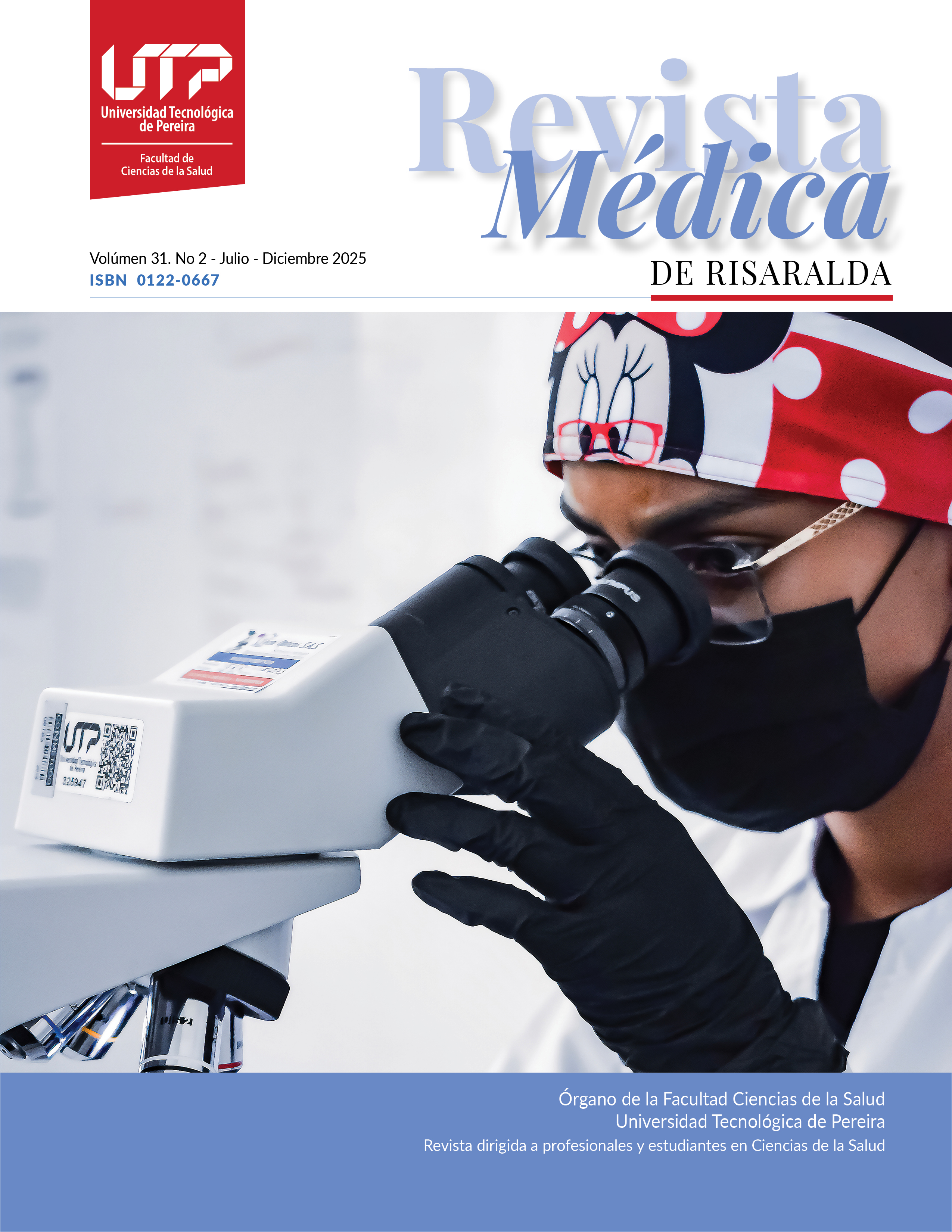Risk Factors Associated with Intrauterine Fetal Demise (IUFD) in Pregnant Women Managed at a Tertiary-Level Hospital in Neiva, Huila, from January 2018 to September 2023
DOI:
https://doi.org/10.22517/25395203.25747Keywords:
Stillbirth, Risk factors, Maternal characteristics, Fetal characteristicsAbstract
Objective: Determine the risk factors associated with stillbirth at the Hospital Universitario Hernando Moncaleano Perdomo from January 1, 2018, to September 30, 2023.
Methodology: Retrospective, observational study conducted at a single center on the clinical characteristics of pregnant women who experienced stillbirth. A probabilistic sampling, by convenience, using simple randomization was performed. Consecutive records from patients diagnosed with stillbirth and admitted to the Hospital Universitario Hernando Moncaleano Perdomo in Neiva, Huila, Colombia, between January 2018 and September 2023.
Results: A total of 79 patients were included during the study period who met the inclusion criteria. The main findings related to fetal death in the studied population were that 49.4% of the mothers had attended fewer than three prenatal visits (21.5% had no prenatal visits), with the presence of pathologies such as diabetes (5.1%) or hypertension during pregnancy (3.8%), as well as excess weight during pregnancy.
Stillbirth occurred more frequently in the third trimester (82.3%), however, 74.7% of the deaths occurred before 37 weeks. Additionally, 3.8% of fetal deaths occurred in women with a history of ≥2 previous losses in 5.1% of the patients.
Conclusion: The most frequent findings in cases of fetal death were intrauterine abruptio placentae, followed by cord prolapse and fetal malformations, mainly congenital heart defects. None of these findings showed statistical significance.
Downloads
References
American College of Obstetricians and Gynecologists; Society for Maternal-Fetal Medicine; Metz TD, Berry RS, Fretts RC, Reddy UM, Turrentine MA. Obstetric care consensus No. 10: Management of stillbirth (replaces Practice Bulletin No. 102, March 2009). Am J Obstet Gynecol. 2020 Mar;222(3):B2-B20. doi:10.1016/j.ajog.2020.01.017
FIGO. Standing Committee on Perinatal Mortality and Morbidity. Report of the FIGO Committee on Perinatal Mortality and Morbidity following a Workshop on Monitoring and Reporting Perinatal Mortality and Morbidity, 1982.
Stanton C, Lawn JE, Rahman H, Wilczynska-Ketende K, Hill K. Stillbirth rates: delivering estimates in 190 countries. Lancet. 2006 May 6;367(9521):1487-94. doi:10.1016/S0140-6736(06)68586-3
Liu LC, Huang HB, Yu MH, Su HY. Analysis of intrauterine fetal demise: a hospital-based study in Taiwan over a decade. Taiwan J Obstet Gynecol. 2013 Dec;52(4):546-50. doi:10.1016/j.tjog.2013.10.016
Simpson LL. Maternal medical disease: risk of antepartum fetal death. Semin Perinatol. 2002 Feb;26(1):42-50. doi:10.1053/sper.2002.29838
Efkarpidis S, Alexopoulos E, Kean L, Liu D, Fay T. Case-control study of factors associated with intrauterine fetal deaths. MedGenMed. 2004 May 27;6(2):53.
Kaufman HK, Hume RF Jr, Calhoun BC, Carlson N, Yorke V, Elliott D, Evans MI. Natural history of twin gestation complicated by in utero fetal demise: associations of chorionicity, prematurity, and maternal morbidity. Fetal Diagn Ther. 2003 Nov-Dec;18(6):442-6. doi:10.1159/000073140
Wu HY, Huang SC, Huang HC, Hsu TY, Lan KC. Cytomegalovirus infection and fetal death in one monozygotic twin. Taiwan J Obstet Gynecol. 2011 Jun;50(2):230-2. doi:10.1016/j.tjog.2011.01.008
Rasmussen S, Irgens LM, Skjærven R, Melve KK. Prior adverse pregnancy outcome and the risk of stillbirth. Obstet Gynecol. 2009 Dec;114(6):1259-70. doi:10.1097/AOG.0b013e3181c22422
Loeb LJ, Gaither K, Woo KS, Mason TC. Outcomes in gestations between 20 and 25 weeks with preterm premature rupture of membranes. South Med J. 2006 Jul;99(7):709-12. doi:10.1097/01.smj.0000224302.43932.f7
Gordon A, Lahra M, Raynes-Greenow C, Jeffery H. Histological chorioamnionitis is increased at extremes of gestation in stillbirth: a population-based study. Infect Dis Obstet Gynecol. 2011;2011:456728. doi:10.1155/2011/456728
Flenady V, Koopmans L, Middleton P, Frøen JF, Smith GC, Gibbons K, et al. Major risk factors for stillbirth in high-income countries: a systematic review and meta-analysis. Lancet. 2011 Apr 16;377(9774):1331-40. doi:10.1016/S0140-6736(10)62233-7
Cheong-See F, Schuit E, Arroyo-Manzano D, Khalil A, Barrett J, Joseph KS, et al. Prospective risk of stillbirth and neonatal complications in twin pregnancies: systematic review and meta-analysis. BMJ. 2016 Sep 6;354:i4353. doi:10.1136/bmj.i4353
Escañuela Sánchez T, Meaney S, O'Donoghue K. Modifiable risk factors for stillbirth: a literature review. Midwifery. 2019 Dec;79:102539. doi:10.1016/j.midw.2019.102539
Hammad IA, Blue NR, Allshouse AA, Silver RM, Gibbins KJ, Page JM, et al. Umbilical cord abnormalities and stillbirth. Obstet Gynecol. 2020 Mar;135(3):644-52. doi:10.1097/AOG.0000000000003676
Gardosi J. Preventing stillbirth: risk factors, case reviews, care pathways. J Perinat Med. 2022 Jun 22;50(6):639-41. doi:10.1515/jpm-2022-0272
Nkwabong E, Megoze Tanon A, Nguefack Dongmo F. Risk factors for stillbirth after 28 complete weeks of gestation. J Matern Fetal Neonatal Med. 2022 Dec;35(25):6368-72. doi:10.1080/14767058.2021.1912727
Moraitis AA, Oliver-Williams C, Wood AM, Fleming M, Pell JP, Smith G. Previous caesarean delivery and the risk of unexplained stillbirth: retrospective cohort study and meta-analysis. BJOG. 2015 Oct;122(11):1467-74. doi:10.1111/1471-0528.13461
Castillo MC, Vwalika B, Stoner MCD, Chi BH, Stringer JSA, Kasaro M, et al. Risk of stillbirth among Zambian women with a prior cesarean delivery. Int J Gynaecol Obstet. 2018 Dec;143(3):360-6. doi:10.1002/ijgo.12668
Thompson RA, Thompson JMD, Wilson J, Cronin RS, Mitchell EA, Raynes-Greenow CH, et al. Risk factors for late preterm and term stillbirth: a secondary analysis of an individual participant data meta-analysis. BJOG. 2023 Aug;130(9):1060-70. doi:10.1111/1471-0528.17444
Zile I, Ebela I, Rumba-Rozenfelde I. Maternal risk factors for stillbirth: a registry-based study. Medicina (Kaunas). 2019 Jul 1;55(7):326. doi:10.3390/medicina55070326
Downloads
-
Vistas(Views): 179
- PDF (Español (España)) Descargas(Downloads): 150
- PDF Descargas(Downloads): 16
Published
How to Cite
Issue
Section
License
Cesión de derechos y tratamiento de datos
La aceptación de un artículo para su publicación en la Revista Médica de Risaralda implica la cesión de los derechos de impresión y reproducción, por cualquier forma y medio, del autor a favor de Facultad de Ciencias de la Salud de la Universidad Tecnológica de Pereira. 1995-2018. Todos los derechos reservados ®
por parte de los autores para obtener el permiso de reproducción de sus contribuciones. La reproducción total o parcial de los trabajos aparecidos en la Revista Médica de Risaralda, debe hacerse citando la procedencia, en caso contrario, se viola los derechos reservados.
Asimismo, se entiende que los conceptos y opiniones expresados en cada trabajo son de la exclusiva responsabilidad del autor, sin responsabilizarse ni solidarizarse, necesariamente, ni la redacción, ni la editorial.
Es responsabilidad de los autores poder proporcionar a los lectores interesados copias de los datos en bruto, manuales de procedimiento, puntuaciones y, en general, material experimental relevante.
Asimismo, la Dirección de la revista garantiza el adecuado tratamiento de los datos de carácter personal



